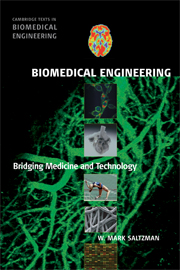Book contents
- Frontmatter
- Contents
- Preface
- Acknowledgments
- Abbreviations and Acronyms
- 1 Introduction: What Is Biomedical Engineering?
- PART 1 MOLECULAR AND CELLULAR PRINCIPLES
- PART 2 PHYSIOLOGICAL PRINCIPLES
- PART 3 BIOMEDICAL ENGINEERING
- 10 Biomechanics
- 11 Bioinstrumentation
- 12 Bioimaging
- 13 Biomolecular Engineering I: Biotechnology
- 14 Biomolecular Engineering II: Engineering of Immunity
- 15 Biomaterials and Artificial Organs
- 16 Biomedical Engineering and Cancer
- Appendix A Physiological Parameters
- Appendix B Chemical Parameters
- Appendix C Units and Conversion Factors
- Index
- Plate section
- References
16 - Biomedical Engineering and Cancer
from PART 3 - BIOMEDICAL ENGINEERING
- Frontmatter
- Contents
- Preface
- Acknowledgments
- Abbreviations and Acronyms
- 1 Introduction: What Is Biomedical Engineering?
- PART 1 MOLECULAR AND CELLULAR PRINCIPLES
- PART 2 PHYSIOLOGICAL PRINCIPLES
- PART 3 BIOMEDICAL ENGINEERING
- 10 Biomechanics
- 11 Bioinstrumentation
- 12 Bioimaging
- 13 Biomolecular Engineering I: Biotechnology
- 14 Biomolecular Engineering II: Engineering of Immunity
- 15 Biomaterials and Artificial Organs
- 16 Biomedical Engineering and Cancer
- Appendix A Physiological Parameters
- Appendix B Chemical Parameters
- Appendix C Units and Conversion Factors
- Index
- Plate section
- References
Summary
LEARNING OBJECTIVES
After reading this chapter, you should:
Understand the magnitude of the problem of cancer in modern society.
Develop an elementary understanding of the biology of cancer cells and be able to describe some of the methods for characterizing the progression of tumors in cancer patients.
Know some of the ways that ionizing radiation interacts with biological tissues and understand the use of radiation in treatment of solid tumors.
Understand the role of surgery in diagnosis and treatment of tumors and be able to predict some of the ways that surgical treatments for cancer will develop in the future.
Understand the value and limitations of chemotherapy in the treatment of cancer.
Know about some of the new approaches, based on our understanding of the molecular and cellular biology of cancer, for creating biological treatments.
Prelude
Cancer is a common, often life-threatening, disease involving the uncontrolled growth and spread of abnormal cells. Cancer is one of the leading causes of death in the world, particularly in developed nations such as the United States. Cancer is really a group of diseases; it can arise in any organ of the body and has differing characteristics that depend on the site of the cancer, the degree of spread, and other factors. Mutations in certain genes within cells—called proto-oncogenes and tumor suppressor genes—are the primary cause of cancer (1).
Sadly, almost every college student has some knowledge of cancer, gained through experience with classmates, family members, or friends.
Information
- Type
- Chapter
- Information
- Biomedical EngineeringBridging Medicine and Technology, pp. 572 - 604Publisher: Cambridge University PressPrint publication year: 2009
